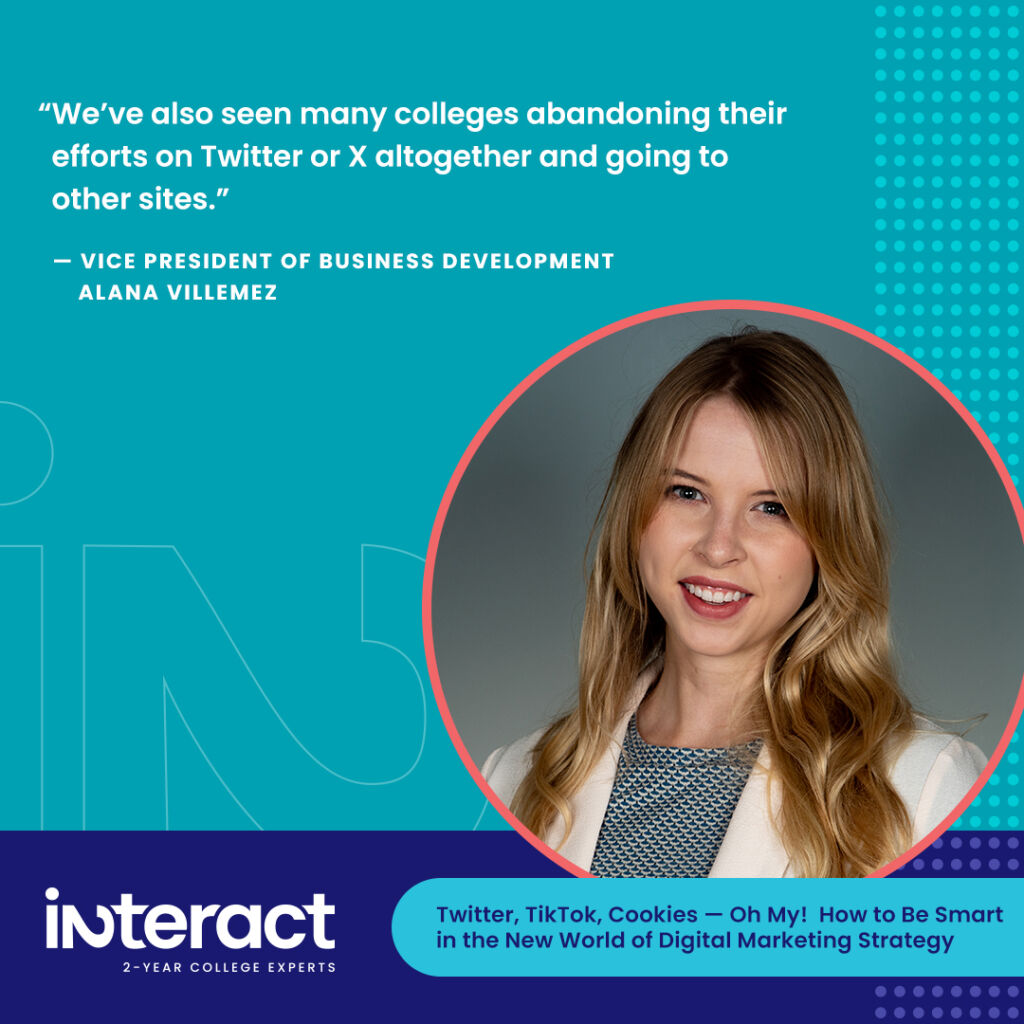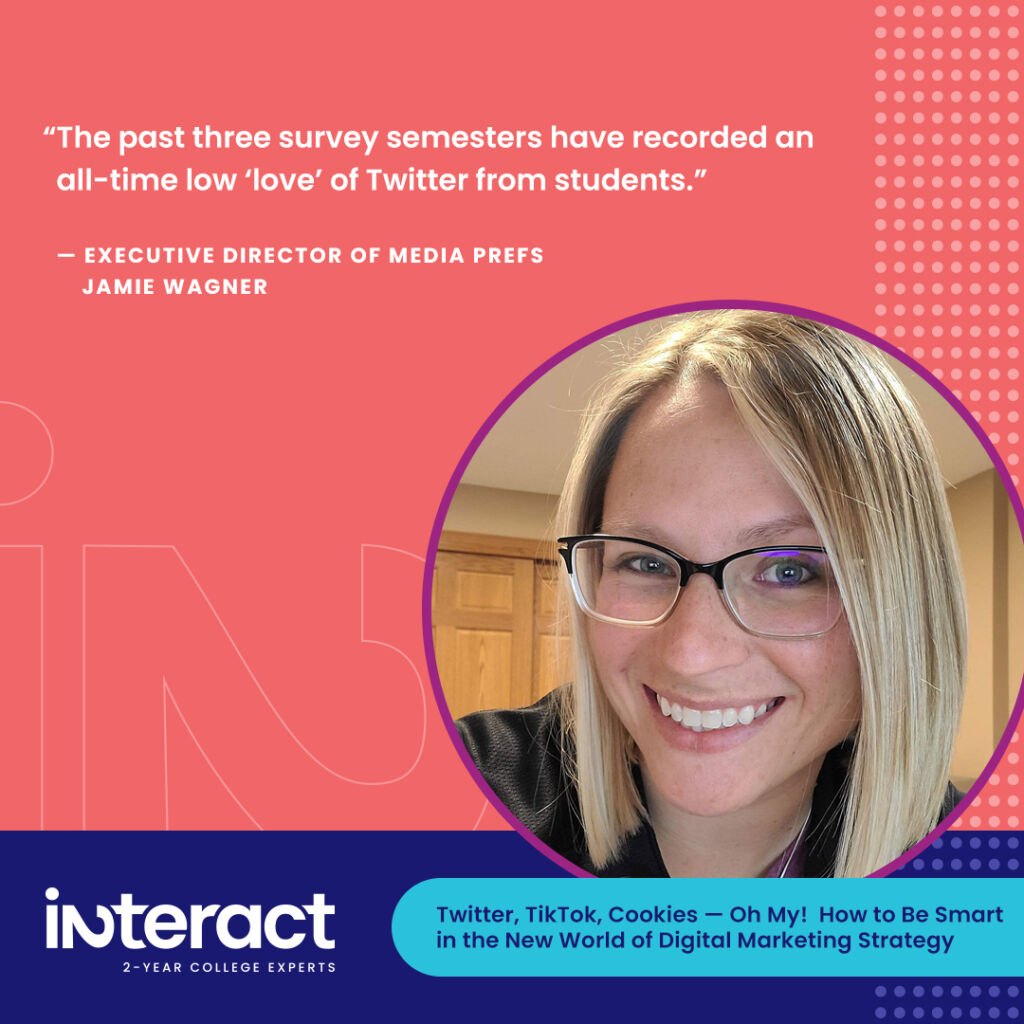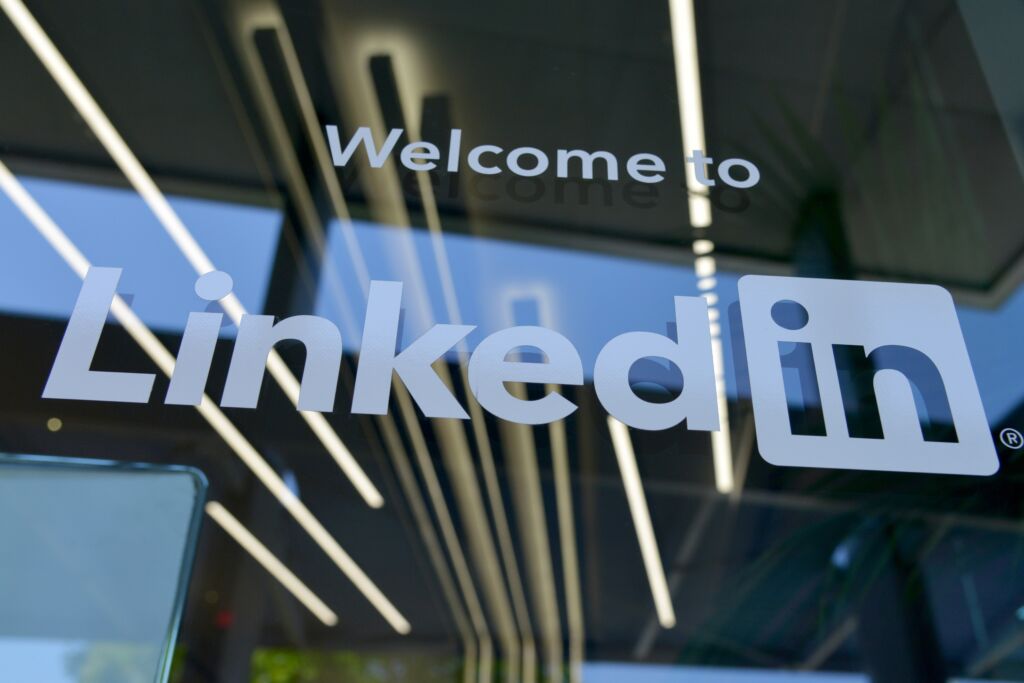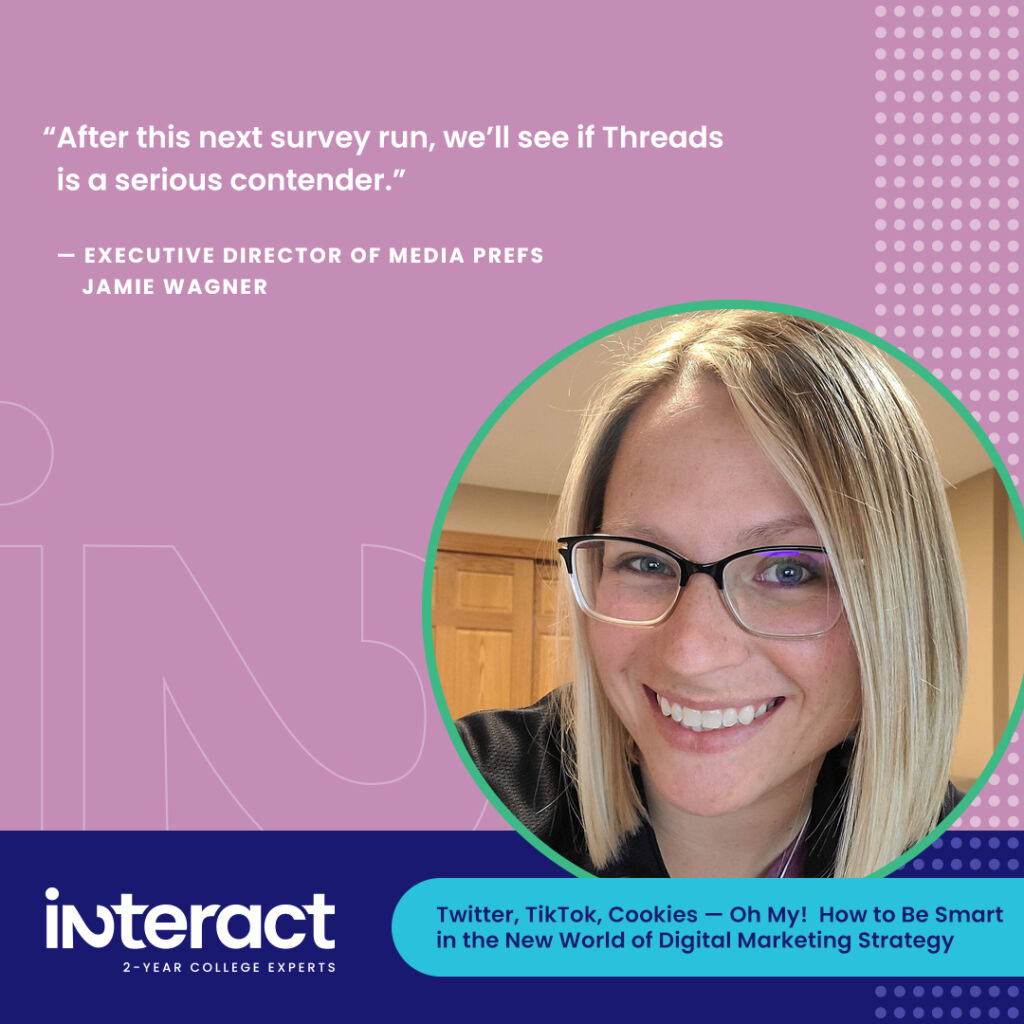Digital marketing strategy can be tough because the online landscape evolves rapidly. Over the last few years, three seismic shifts have overhauled digital marketing strategy for many college marketers:
- Twitter, or X, continues to sink under the weight of challenging leadership.
- TikTok is under investigation for security issues by the U.S. government and beyond.
- And let’s not forget the Apple iOS 14 ad tracking changes significantly impacting the global digital advertising industry and the end of third-party cookies.
What’s a college marketer to do? Keep reading for our survival guide with tips from Interact’s Vice President of Business Development, Alana Villemez, and Executive Director of Interact’s Media Preferences, Jamie Wagner!
Digital Marketing Strategy Shift #1: Surviving Twitter’s Collapse

“We’ve seen colleges shift from having an organization-wide Twitter or X profile to individual accounts for presidents and leadership instead,” says Villemez. “But we’ve also seen many colleges abandoning their efforts on Twitter or X altogether and going to other sites.”
Twitter (now X) is losing appeal. According to The Guardian, Twitter is estimated to lose 32 million users worldwide by 2024.
“Aside from all the glitches, bugs and outages, the user experience of Twitter has declined noticeably. … Twitter has also stopped allowing third-party apps — which have been an integral part of the user experience and of Twitter’s very development — to access its data freely, meaning most of these apps are now defunct.”
Elon Musk’s Twitter Is Dying a Slow and Tedious Death, The Financial Times
Now, of course, Twitter has rebranded as “X,” spawning memes of dead blue birds with an X instead of an eye, as in The Daily Beast article, “Elon Musk’s Clumsy Twitter Rebrand to ‘X’ Falls Flat on Its Face.”
According to a new survey from Hubspot, 34% of marketing respondents plan to move off of Twitter, while 66% say they’ll stay. But across the board, 71% reported that they plan to spend less time on the platform. Many were concerned about the app’s security issues and the rise of hate speech on the platform.
What Is the Twitter Usage by Community College Student Audiences?
Fortunately, Twitter was never students’ go-to social media platform, according to our national Media Prefs data. Only 3%-10% of students claimed that Twitter was their favorite platform over the years.

“The past three survey semesters have recorded an all-time low ‘love’ of Twitter from students,” says Jamie Wagner, our Executive Director of Media Prefs. “This is true even of male students, who have traditionally favored the platform more than their female counterparts.”
Reaching Key Stakeholders: Expanding the Use of LinkedIn

Twitter had helped many of our community college clients reach influential partners like politicians and business leaders.
“If colleges were originally engaging with employers or industry partners on Twitter, they are moving to LinkedIn or even consolidating that strategy into their email newsletter,” says Villemez. “LinkedIn is a very helpful platform for employer engagement and overall PR.”

What about Threads?
In the wake of Twitter’s collapse, Meta released Threads on July 5, 2023, and it has become a popular alternative. However, it lacks many features that made Twitter robust, such as hashtags, and the platform is still under development.
Media Prefs just added Threads as a survey option to track how well it performs with students.
“We’ll be anxious to see where this new X (Twitter) competitor falls in relation to our larger platforms,” says Wagner. “After this next survey run, we’ll see if Threads is a serious contender.”

Wagner adds that usage on the Threads app has plummeted significantly since its 100 million sign-ups in the first week, with less than half of the initial subscribers still using it. Still, as Threads gains more functionality, usage might climb again.
Digital Marketing Strategy Shift #2: The TikTok Dilemma
TikTok has more than 1 billion monthly users. And according to the Pew Research Center, roughly two-thirds of U.S. teens use the platform.
However, there have been TikTok bans in different states and countries worldwide. TikTok has repeated violations of public trust and compromised user privacy. Most of all, there are security concerns that the Chinese government may use TikTok to spy on users.
In fact, more than 15 countries have placed bans or restrictions on TikTok, including Australia, the U.K., France, India, Norway, and Canada. The U.S. launched a criminal investigation into TikTok in March.
How Many Community College Students Use TikTok?
“We added TikTok as a survey option in the fall of 2019, and it’s done nothing but increase in popularity each semester since,” says Wagner. “The biggest jump in popularity was from spring 2020 to fall 2020, at the onset of the pandemic.”

Our Media Prefs data shows that TikTok became a sensation for traditional (ages 18-20) female students. In this demographic, it surpassed Snapchat in popularity in the fall of 2020. In the spring of 2021, the platform even outstripped Instagram, taking the throne for this segment’s most preferred social platform. Today, TikTok still reigns supreme with traditional female students.
Maximizing Short-Form Video Outside of TikTok
With the ever-changing social media landscape, it makes sense to diversify platforms to maximize impact. Since short-form videos are so popular, we advise using Instagram Reels and YouTube Shorts.
“Short-form videos are the kind of content you have to make cyclically, once a week or every two weeks, to be successful,” says Villemez. “But the good news is that the content does not need to be high quality — people are used to filming short videos on their phones.

“Short-form videos are a great way to leverage your students and the authentic voice of your college.”
What’s the sweet spot for a video to gain the most engagement and ROI? Says Villemez, “15 to 20 seconds is the way to go.”
YouTube is ‘A Sure Bet’
“Social platforms are, for the most part, subject to a lot of volatility,” says Wagner. “We see them ebb and flow over the years.”
However, our Media Prefs executive director says that one platform has remained a sure bet for colleges: YouTube.
“With only 16% of students nationally saying that they ‘never’ or ‘rarely’ use the platform, YouTube gets plenty of eyes across all demographics,” says Wagner.

YouTube is a favorite of male students. And 78% of prospective (ages 16-17) and traditional (ages 18-20) male students claim they’re frequently or always on the platform.
Female students tend to have more diversified interests in social media. But you can still catch over half (56%) of prospective and traditional-aged female students who are highly engaged on YouTube.
How to Be Smart with Your Social and Digital Marketing Strategy
The past three years have been a time of innovation and adaptation regarding the changing digital landscape. So, take time to reflect and reevaluate where you spend your marketing dollars to refine your digital marketing strategy. For more, read “Marketing Strategy: How to Take a Digital Marketing Inventory and Boost Your Enrollment.”
And remember, target specific audiences and dial in on generation, gender, location, and language. Use the right platform at the right time with the right message, and you can create more personalized content to yield greater engagement. Utilizing Media Prefs along with zero- and first-party data can help.

“Community colleges need to understand that other businesses are already leveraging zero- and first-party data, so our students are used to it,” says Villemez. “Some people actually prefer this way of interacting because they want to receive messages that are catered to them and have a personal feel.”
What are zero- and first-party data? We’re glad you asked because it brings us to our next topic …
Digital Marketing Strategy Shift #3: The Problem with the New Apple Privacy Setting and the End of Third-Party Cookies

When Apple’s iOS updated its privacy terms in 2021, it enhanced user security across devices. However, the move had major ramifications for digital advertising.
Apple’s new privacy policy limits third-party cookies tracking user behavior across websites. This means advertisers and third parties can no longer access personal data without users’ consent. Facebook and Instagram advertising have been most affected by this change.
Our 2022-23 Media Prefs data shows that 68% of community college students have iPhones. iPhone use ranges from 50% of those age 51+ to 75% of those ages 18-25. Plus, Meta and Google are increasingly limiting third-person cookies, so even Android phones will have similar tracking issues. This means that it has become increasingly challenging to track prospects and students with third-party cookies.
In other words, it’s time to leverage your zero- and first-person data instead.
“You have to think through creating a more personalized inquiry system,” says Villemez. “You must collect those student inquiries and follow up.”

What are Zero- and First-Person Cookies, and How Do They Affect Your Digital Marketing Strategy?
Leveraging zero- and first-party data is key to successful outreach and targeting audiences across advertising platforms. But what are they?
It’s as Easy as 0, 1, 2, 3: Data Explained:
- Zero-party data is when a consumer shares personal information directly with a brand.
- First-party data is when a brand collects information during consumer interactions, such as insights from analytics and user activity.
- Second-party data is when first-party data is shared with another company through an agreement.
- Third-party data is aggregated information that can come from various sources.

“The first step is to start collecting inquiries systematically, especially on your website,” says Villemez. “It’s not hard. And even if you don’t have a CRM, you can still create a protected spreadsheet to collect that data.
“Zero- and first-party data can help you build authentic messaging and brand loyalty when your communications are personalized.”
How to Collect Data
Collecting zero-party data requires direct contact with your target audience. The information can help you understand learners’ wants and needs to create more personalized experiences along the student journey. But it does take extra work to collect this data through request-for-information forms (RFIs), surveys, registration forms, and more.
There are lots of ways to encourage more inquiries.
“Pay-per-click is huge for getting inquiries right off the bat. So are postcard mailers with QR codes that lead to landing pages where prospects can submit their information,” says Villemez. “You can even collect inquiries straight from Facebook and Instagram, especially with ‘lead ads.’ We see magic happen with those social media inquiries in the conversion process.”

And as our VP reminds our partners, remember to give audiences control of how they interact with your brand. Don’t just offer a one-size-fits-all opt-out option! Offer choices and preferences to maintain healthy engagement.
Interact has helped community colleges nationwide dial in their lead generation and digital marketing strategy. Instead of just driving traffic to a landing page or college website, we’ll help increase inquiry opportunities within your platform.
Just take Truckee Meadows Community College, where we helped their noncredit marketing campaign collect more student information, increasing program retention by 80%!

“Everyone who submitted an inquiry was automatically added to an action workflow to prompt students to the next milestone,” says Villemez. “Now, the Truckee Meadows Community College team can work as case managers to help students with specific tasks if they haven’t completed a milestone or to move through the funnel.”
Do you need help collecting and leveraging your data? Schedule a free consultation — we’d love to help you find innovative solutions.
The Secrets to Adapting Your Digital Marketing Strategy
Students have always expected a lot from colleges. And they definitely crave a consistent brand experience — no matter where they find your information. That means enacting a cross-channel digital marketing strategy is a must to increase engagement and awareness.
What are the multiple student touchpoints you can create to sway students? According to Google, it typically takes six to nine months and up to 30 digital interactions before prospects decide to apply. That’s why well-rounded strategies that include influencer campaigns, email marketing, and integrated social media content are crucial.
“How can we foster inquiries and ensure they are integrated into the larger funnel?” says Villemez. “It’s about leveraging your digital marketing and making sure those prospects actually get converted into your pipeline.”

Does your college have a unique digital marketing strategy challenge? We can help you find bold new solutions — book a complimentary consultation with our experts today!



